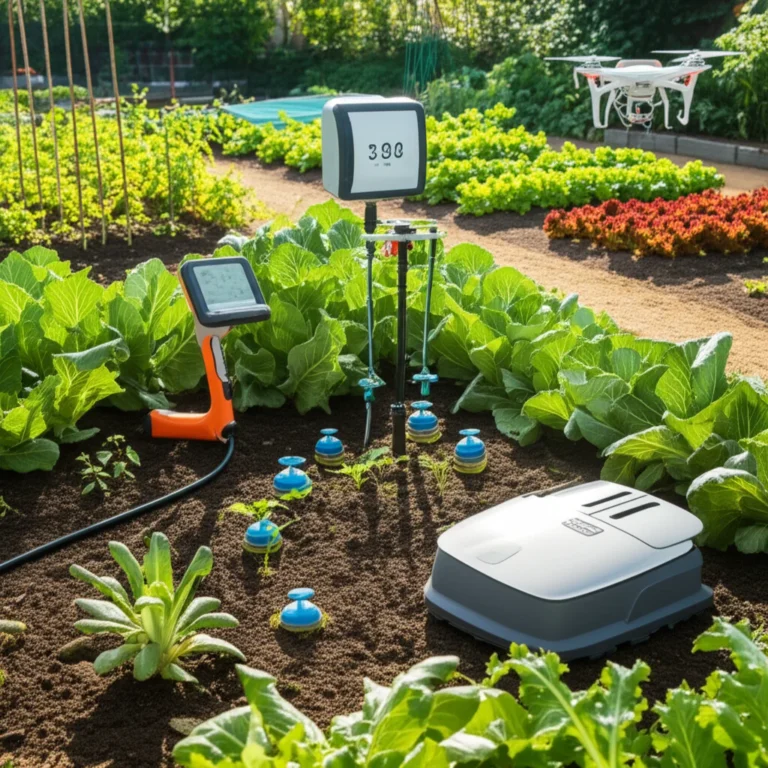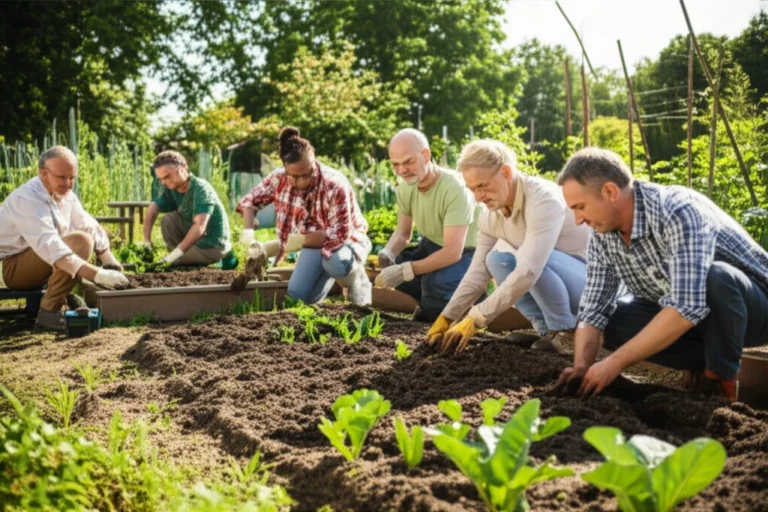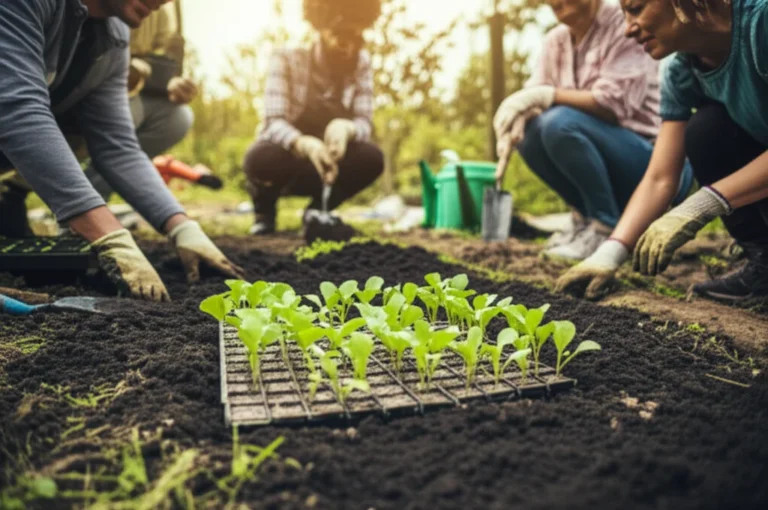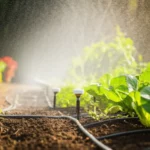Support our educational content for free when you purchase through links on our site. Learn more
Imagine a patch of land in the heart of your neighborhood where kids learn to plant their first seeds, families discover the joy of fresh, homegrown veggies, and communities unite to tackle food insecurity — all while having fun and gaining real skills. Sounds like a dream? Well, community gardens are making this a vibrant reality across cities worldwide. But can these green spaces truly serve as effective educational tools for gardening, nutrition, and food security? Spoiler alert: yes, and then some!
In this article, we’ll explore 9 powerful ways community gardens cultivate knowledge, empower individuals, and build resilient food systems. From hands-on gardening lessons to nutrition workshops and innovative tech integration, community gardens are blossoming into dynamic classrooms for all ages. Plus, we’ll share insider tips from the Community Gardening™ team and inspiring real-world examples that prove these gardens are more than just pretty plots — they’re seeds of change.
Ready to dig in and discover how your local garden can become a thriving educational hub? Let’s grow together!
Key Takeaways
- Community gardens provide hands-on, intergenerational learning that teaches gardening basics, soil science, and sustainable practices.
- They are effective platforms for nutrition education, connecting people to fresh food and healthy eating habits.
- Gardens play a critical role in enhancing food security by increasing access to fresh produce and fostering local resilience.
- Successful educational gardens rely on strong administration, trained leaders, and community partnerships.
- Integrating technology and innovation like apps and hydroponics keeps education engaging and accessible.
- Overcoming challenges such as funding and volunteer burnout is possible with strategic planning and community spirit.
👉 Shop Gardening Essentials:
- Fiskars Garden Tool Set on Amazon | Walmart
- Burpee Organic Seeds on Amazon | Burpee Official Website
- Gardenize App — track your garden digitally!
Table of Contents
- Quick Tips and Facts 🌱
- Rooted in History: The Evolution of Community Gardens as Learning Hubs 🌿
- 1. How Community Gardens Cultivate Gardening Skills for All Ages 🌻
- 2. Growing Knowledge: Teaching Nutrition Through Hands-On Garden Experiences 🥕
- 3. Food Security and Community Gardens: Planting Seeds for a Resilient Future 🍅
- 4. Educational Programs and Workshops: Tools to Empower Gardeners and Eaters 📚
- 5. Administration and Organization: Running a Successful Educational Community Garden 🛠️
- 6. Training Garden Leaders: Cultivating Expertise and Passion in Educators 🌼
- 7. Resources and Partnerships: Leveraging Community and Institutional Support 🤝
- 8. Technology and Innovation: Modern Tools Enhancing Garden Education 🌐
- 9. Overcoming Challenges: Common Obstacles and How to Thrive in Community Garden Education 🚧
- Conclusion: Harvesting the Full Potential of Community Gardens as Educational Tools 🌟
- Recommended Links for Gardeners and Educators 🌍
- FAQ: Your Burning Questions About Community Garden Education Answered ❓
- Reference Links and Further Reading 📖
Quick Tips and Facts 🌱
Welcome to the green heart of our article! Before we dig deep, here are some quick tips and fascinating facts about using community gardens as educational tools for gardening, nutrition, and food security:
- ✅ Community gardens boost hands-on learning — people learn best by doing!
- ✅ They provide real-world experience growing fruits and veggies, which helps reinforce nutrition lessons.
- ✅ Gardens foster food security awareness by showing how local food production can reduce reliance on distant supply chains.
- ✅ According to the American Community Gardening Association, community gardens increase access to fresh produce and improve dietary habits.
- ✅ Gardens are perfect for intergenerational learning — kids, adults, and seniors all benefit.
- ✅ Educational programs in gardens can include soil science, composting, pest management, cooking demos, and food preservation.
- ✅ Community gardens nurture social bonds and empower neighborhoods to tackle food deserts and nutrition inequality.
For a deeper dive into the purpose of community gardens, check out our article What is the purpose of a community garden?.
Ready to grow your knowledge? Let’s dig in! 🌿
Rooted in History: The Evolution of Community Gardens as Learning Hubs 🌿

Community gardens have been around for centuries, but their role as educational tools has blossomed especially in recent decades. Let’s trace this fascinating journey:
The Origins of Community Gardening Education
- Victory Gardens in WWI & WWII: These gardens taught millions how to grow food during wartime shortages, sparking a surge in gardening knowledge nationwide.
- Urban Renewal and Food Justice Movements: In the 1960s-70s, community gardens became spaces for empowerment and education in underserved neighborhoods.
- Modern Sustainable Agriculture: Today, gardens are hubs for teaching organic methods, permaculture, and climate-resilient gardening.
The Shift to Holistic Education
Community gardens evolved beyond just growing food. They now teach:
- Nutrition education — understanding what foods nourish the body.
- Food security concepts — how local food systems can reduce hunger and improve health.
- Environmental stewardship — composting, water conservation, and biodiversity.
Anecdote from Community Gardening™
Our team recalls a garden in Detroit where a local school partnered with a community garden to teach kids about soil microbes — turning science class into a muddy, magical adventure! The kids’ enthusiasm skyrocketed, proving that learning sticks best when it’s hands-on and fun.
1. How Community Gardens Cultivate Gardening Skills for All Ages 🌻
Community gardens are like living classrooms where everyone can learn the art and science of gardening. Here’s how they nurture skills across generations:
Hands-On Learning: The Best Teacher
- Planting and Propagation: Seeds, cuttings, and seedlings teach biology basics and patience.
- Soil Science: Understanding soil types, pH, and nutrients helps gardeners optimize growth.
- Watering and Irrigation: Learning efficient watering conserves resources and promotes healthy plants.
- Pest and Disease Management: Identifying pests and using organic controls teaches integrated pest management (IPM).
- Harvesting and Crop Rotation: Timing and techniques improve yields and soil health.
Skill-Building Workshops
Many community gardens offer workshops led by experienced gardeners or partnering organizations like The National Gardening Association. Topics include:
- Composting basics
- Raised bed construction
- Seasonal planting calendars
- Seed saving and heirloom varieties
Benefits for Different Age Groups
| Age Group | Gardening Benefits | Educational Focus |
|---|---|---|
| Children | Motor skills, responsibility, curiosity | Plant biology, ecology, nutrition |
| Teens | Leadership, teamwork, career exploration | Sustainable agriculture, entrepreneurship |
| Adults | Stress relief, health, community building | Advanced gardening techniques, nutrition |
| Seniors | Physical activity, socialization | Therapeutic gardening, legacy skills |
Real Story: From Novice to Green Thumb
One of our gardeners, Maria, started with zero experience. Through community garden classes and mentorship, she now teaches others how to grow tomatoes organically. This ripple effect shows how community gardens empower individuals to become educators themselves.
2. Growing Knowledge: Teaching Nutrition Through Hands-On Garden Experiences 🥕
Gardening is a gateway to understanding nutrition — and community gardens are the perfect classroom!
Why Gardens Are Ideal for Nutrition Education
- Seeing is Believing: Growing your own food makes nutrition tangible.
- Taste Tests: Sampling fresh-picked produce encourages trying new, healthy foods.
- Cooking Demos: Gardens often partner with chefs or nutritionists to teach simple, nutritious recipes.
- Food Label Literacy: Understanding where food comes from helps people make informed choices.
Nutritional Lessons Embedded in Gardening
- Vitamins and minerals in different vegetables
- Importance of fiber and antioxidants
- Seasonal eating and its health benefits
- Reducing processed food consumption by growing fresh produce
Community Gardening™ Tip: Pair garden tours with nutrition talks to maximize impact.
Example Program: UDC’s Lamond-Riggs Urban Food Hub
As highlighted by the University of the District of Columbia’s Center for Urban Agriculture and Gardening Education, their demonstration kitchen teaches food safety and nutrition alongside gardening skills — a holistic approach that’s changing lives in Washington, D.C.
3. Food Security and Community Gardens: Planting Seeds for a Resilient Future 🍅
Food security is a pressing issue worldwide, and community gardens play a vital role in addressing it locally.
How Community Gardens Enhance Food Security
- Increase Access to Fresh Produce: Especially in food deserts where grocery stores are scarce.
- Reduce Food Costs: Growing your own food lowers grocery bills.
- Build Community Resilience: Shared knowledge and resources help neighborhoods withstand supply chain disruptions.
- Promote Sustainable Practices: Local growing reduces environmental impact.
Key Food Security Concepts Taught in Gardens
- Seasonal and year-round growing strategies
- Preservation techniques like canning and freezing
- Seed saving for future crops
- Water and soil conservation methods
Case Study: East Capitol Urban Farm
The East Capitol Urban Farm transforms a vacant lot into a food-producing oasis, improving access to fresh produce in Ward 7, D.C. Their integrated approach includes education on food prep, distribution, and waste management — a full-circle model for food security.
4. Educational Programs and Workshops: Tools to Empower Gardeners and Eaters 📚
Community gardens thrive when paired with structured educational programs. Here’s how they work:
Types of Educational Offerings
- Gardening 101: Basics for beginners
- Advanced Horticulture: Soil amendments, pest control, crop rotation
- Nutrition and Cooking Classes: From garden to table
- Youth Engagement: Summer camps, after-school programs
- Sustainability Workshops: Composting, rainwater harvesting, pollinator gardens
Designing Effective Programs
- Use hands-on activities for engagement.
- Incorporate multisensory learning — touch, smell, taste, sight.
- Partner with local experts: Extension services, nutritionists, chefs.
- Tailor content to community needs and cultural preferences.
Community Gardening™ Experience
We’ve seen gardens flourish when they host seasonal workshops paired with community potlucks — nothing bonds like sharing food you grew yourself! These events spark curiosity and encourage lifelong learning.
5. Administration and Organization: Running a Successful Educational Community Garden 🛠️
Behind every thriving educational garden is solid administration. Here’s what it takes:
Key Administrative Elements
- Clear Mission and Goals: Define educational objectives alongside gardening goals.
- Volunteer Coordination: Recruit, train, and schedule volunteers effectively.
- Partnership Development: Collaborate with schools, nonprofits, local government.
- Funding and Grants: Secure resources for tools, seeds, educational materials.
- Communication: Maintain newsletters, social media, and signage to keep participants informed.
Tools and Platforms
- Use platforms like Better Impact for volunteer management.
- Grant databases like Grants.gov help find funding.
- Community forums and apps (e.g., Nextdoor) boost engagement.
Pro Tip from Community Gardening™
Document your garden’s educational outcomes with photos, testimonials, and data. This helps attract funding and support by showcasing impact.
6. Training Garden Leaders: Cultivating Expertise and Passion in Educators 🌼
Great educational gardens need passionate leaders. Training them is key!
Essential Training Topics
- Teaching techniques for diverse learners
- Conflict resolution and community building
- Sustainable gardening practices
- Nutrition basics and food safety
- Program planning and evaluation
Training Formats
- In-person workshops and field days
- Online webinars and courses (e.g., Master Gardener programs)
- Peer mentoring and shadowing experienced leaders
Community Gardening™ Story
Our lead educator, Jamal, started as a volunteer and grew into a trainer after completing a Master Gardener certification. His journey shows how investing in training creates a ripple effect of knowledge and enthusiasm.
7. Resources and Partnerships: Leveraging Community and Institutional Support 🤝
No garden is an island! Partnerships and resources amplify educational impact.
Valuable Resources
- Extension Services: Provide expertise and materials.
- Local Universities: Offer research support and interns.
- Nonprofits: Like GrowNYC or The GreenThumb Program.
- Government Programs: USDA grants and support programs.
- Corporate Sponsors: Tool donations and funding.
Building Strong Partnerships
- Align goals and expectations clearly.
- Share resources and responsibilities.
- Celebrate successes together to build morale.
Example: P.R. Harris Urban Food Hub
This hydroponic and aquaponic research facility partners with local organizations to develop business models for small-scale urban agriculture, showing how collaboration drives innovation and education.
8. Technology and Innovation: Modern Tools Enhancing Garden Education 🌐
Technology is sprouting new possibilities in garden education!
Innovative Tools
- Mobile Apps: For plant identification, watering reminders, and garden journaling.
- Hydroponics and Aquaponics: Teach soil-less growing and ecosystem balance.
- Online Learning Platforms: Zoom workshops and YouTube tutorials.
- Sensors and IoT: Monitor soil moisture, temperature, and light for data-driven learning.
Benefits of Tech Integration
- Engages younger generations familiar with digital tools.
- Enables remote participation and wider reach.
- Provides precise data for better gardening outcomes.
Community Gardening™ Insight
We’ve integrated apps like Gardenize into our programs, helping gardeners track progress and share results — a digital twist on traditional gardening that keeps learners hooked.
9. Overcoming Challenges: Common Obstacles and How to Thrive in Community Garden Education 🚧
Every garden faces hurdles, but with the right strategies, you can turn challenges into growth opportunities.
Common Challenges
- Limited Funding: Grants and donations can be unpredictable.
- Volunteer Burnout: Keep engagement fresh with varied tasks and recognition.
- Space Constraints: Use vertical gardening and container beds.
- Pests and Weather: Teach organic pest control and climate adaptation.
- Community Conflicts: Foster open communication and shared decision-making.
Solutions and Tips
- Diversify funding sources — crowdfunding, local businesses, events.
- Rotate leadership roles to avoid burnout.
- Use innovative garden designs to maximize space (see Garden Design Ideas).
- Build resilience through education on climate-smart gardening.
- Establish clear community guidelines (see Community Garden Policies).
Final Thought
Challenges are just part of the journey — with passion, planning, and community spirit, your garden can flourish as a vibrant educational hub!
Ready to explore how to harvest the full potential of community gardens as educational tools? Stay tuned for our conclusion and actionable next steps! 🌟
Conclusion: Harvesting the Full Potential of Community Gardens as Educational Tools 🌟

Wow, what a journey through the vibrant world of community gardens as educational powerhouses! From planting your first seed to understanding the complex web of food security, nutrition, and sustainable gardening, community gardens offer an unmatched, hands-on learning experience that benefits individuals and entire neighborhoods alike.
Here’s the bottom line: Community gardens are not just patches of green; they are living classrooms where knowledge grows alongside plants. They teach gardening skills for all ages, foster nutrition awareness through fresh produce, and empower communities to tackle food insecurity head-on. Plus, with the right administration, training, and partnerships, these gardens become hubs of innovation and social cohesion.
We opened the loop earlier about how technology and modern methods like hydroponics and aquaponics can enhance garden education — and as you’ve seen, integrating these tools keeps the learning fresh and accessible, especially for younger generations.
Our confident recommendation? Whether you’re a city planner, educator, or passionate gardener, investing in community gardens as educational tools is a win-win. They nurture not only plants but also knowledge, health, and community spirit. So get your hands dirty, gather your neighbors, and start growing a greener, smarter future today!
Recommended Links for Gardeners and Educators 🌍
Ready to equip your community garden with the best tools and resources? Here are some top picks and educational books to get you started:
-
Gardening Tools & Supplies:
-
Educational Books:
- The Vegetable Gardener’s Bible by Edward C. Smith — a must-have for all skill levels. Amazon Link
- Nutrition and Physical Degeneration by Weston A. Price — explores the link between diet and health. Amazon Link
- Urban Agriculture: Ideas and Designs for the New Food Revolution by David Tracey — perfect for urban garden planners. Amazon Link
-
Technology Tools:
- Gardenize App — track and share your garden’s progress digitally.
FAQ: Your Burning Questions About Community Garden Education Answered ❓

How can community gardens promote food security and sustainability in urban areas?
Community gardens increase local access to fresh, nutritious produce, especially in food deserts where grocery stores are scarce. By growing food locally, they reduce dependence on long supply chains vulnerable to disruption. Gardens also teach sustainable practices like composting, water conservation, and crop rotation, which improve soil health and reduce environmental impact. These factors combined help build resilient urban food systems that support community well-being.
What role do community gardens play in educating children about nutrition and healthy eating habits?
Community gardens provide children with hands-on experiences that connect them directly to the food they eat. By planting, tending, and harvesting fruits and vegetables, kids learn about the nutritional value of fresh produce and develop healthier eating habits. Gardens often incorporate cooking demonstrations and taste tests, making nutrition education interactive and fun. This early exposure fosters lifelong appreciation for wholesome foods.
Can community gardens serve as a platform for social cohesion and community building among diverse groups of people?
Absolutely! Community gardens bring together people of all ages, backgrounds, and cultures to work toward a common goal. This shared purpose fosters social bonds, mutual respect, and cultural exchange. Gardens often host events, workshops, and potlucks that celebrate diversity and encourage collaboration. These social connections strengthen neighborhoods and empower communities to address broader issues like food justice and environmental stewardship.
What are some effective strategies for creating and maintaining a successful community garden that supports educational goals and community engagement?
- Define clear educational objectives aligned with community needs.
- Engage diverse stakeholders including schools, nonprofits, and local government.
- Provide regular training and workshops to build skills and enthusiasm.
- Establish strong leadership and volunteer coordination to sustain momentum.
- Leverage partnerships and funding sources for resources and expertise.
- Use innovative garden designs and technology to maximize space and engagement.
- Foster open communication and conflict resolution to maintain harmony.
- Celebrate successes publicly to build pride and attract new participants.
How can technology enhance the educational impact of community gardens?
Technology tools like mobile apps for plant care, online workshops, and sensor-based monitoring systems make gardening more accessible and data-driven. They engage tech-savvy learners and enable remote participation, expanding the garden’s reach. Integrating hydroponics and aquaponics introduces learners to cutting-edge sustainable agriculture methods, preparing them for future food challenges.
Read more about “6 Ways Community Gardens Grow Stronger, Connected Neighborhoods (2025) 🌿”
What challenges do community gardens face in their educational mission, and how can they be overcome?
Common challenges include funding shortages, volunteer burnout, limited space, pest issues, and community conflicts. Solutions involve diversifying funding streams, rotating leadership roles, adopting vertical and container gardening, teaching organic pest management, and establishing clear community guidelines. Education itself is a powerful tool to build resilience and adaptability within the garden community.
Reference Links and Further Reading 📖
- University of the District of Columbia Center for Urban Agriculture and Gardening Education — a leading example of integrated garden education and food security programs.
- American Community Gardening Association — resources and research on community gardening benefits.
- National Gardening Association — educational materials and gardening programs.
- New York State Community Gardens Task Force Report 2023 — comprehensive insights on community gardens’ role in education and food security.
- USDA Community Food Projects — grants and support for community-based food initiatives.
- GrowNYC — urban agriculture and education programs in New York City.
- GreenThumb NYC — city-run community garden support and resources.
Dive into these trusted sources to deepen your understanding and fuel your garden’s educational mission! 🌻





